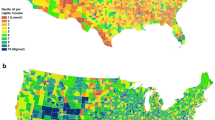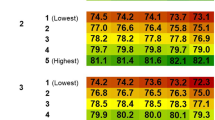Abstract
Objectives
The aims of this study were to examine (1) the concordance between income measured at the individual and area-based level and (2) the impact of using each measure of income on inequality estimates for three health indicators—the prevalence, respectively, of diabetes, smoking, and obesity.
Methods
Data for the health indicators and individual income among adults came from six cycles of the Canadian Community Health Survey (cycles 2003 through 2013). Area-based income was obtained by linking respondents’ residential postal codes to neighbourhood income quintiles derived from the 2006 Canadian census. Relative and absolute inequality between the lowest and highest income quintiles for each measure was assessed using rate ratios and rate differences, respectively.
Results
Concordance between the two income measures was poor in the overall sample (weighted Kappa estimates ranged from 0.19 to 0.21 for all years), and for the subset of participants reporting diabetes, smoking, or obesity. Despite the poor concordance, both individual and area-based income measures identified generally comparable levels of relative and absolute inequality in the rates of diabetes, smoking, and obesity over the 10-year study period.
Conclusion
The results of this study show that individual and area-based income measures categorize Canadians differently according to income quintile, yet both measures reveal striking income-related inequalities in rates of diabetes and smoking, and obesity among women. This suggests that either individual or area-level measures can be used to monitor income-related health inequalities in Canada; however, whenever possible, it is informative to consider both measures since they likely represent distinct social constructs.
Résumé
Objectifs
Examiner (1) la concordance entre le revenu personnel et régional et (2) l’incidence de l’utilisation de chaque indicateur du revenu sur les estimations des inégalités pour trois indicateurs de la santé, soit la prévalence, respectivement, du diabète, du tabagisme et de l’obésité.
Méthode
Les données des indicateurs de la santé et du revenu personnel chez les adultes proviennent de six cycles (2003 à 2013) de l’Enquête sur la santé dans les collectivités canadiennes. Le revenu régional a été obtenu en maillant les codes postaux de résidence des répondants aux quintiles de revenu selon le quartier dérivés du Recensement du Canada de 2006. Les inégalités relatives et absolues entre les quintiles de revenu inférieur et supérieur pour chaque indicateur ont été évaluées par les rapports de taux et les différences de taux, respectivement.
Résultats
La concordance entre les deux indicateurs du revenu est faible dans l’échantillon global (le coefficient kappa pondéré est de 0,19 à 0,21 pour toutes les années) et pour le sous-ensemble de participants ayant fait état de diabète, de tabagisme ou d’obésité. Malgré cette faible concordance, les indicateurs du revenu personnel et régional révèlent des niveaux généralement comparables d’inégalités relatives et absolues dans les taux de diabète, de tabagisme et d’obésité sur les 10 ans de l’étude.
Conclusion
Les résultats de l’étude montrent que les indicateurs du revenu personnel et régional classent les Canadiens différemment selon le quintile de revenu, mais que les deux indicateurs révèlent des inégalités marquantes liées au revenu dans les taux de diabète et de tabagisme, et chez les femmes, dans les taux d’obésité. L’indicateur personnel ou l’indicateur régional peuvent donc l’un et l’autre être utilisés pour surveiller les inégalités de santé liées au revenu au Canada; dans la mesure du possible, il est toutefois instructif de les utiliser tous les deux, car ils représentent probablement des constructions sociales distinctes.




Similar content being viewed by others
References
Agence de la Santé et des Services Sociaux de Montreal. 2011 report of the director of public health. Social inequalities in health in Montreal: Progress to date. Montreal, QC; 2011.
Braveman, P. A., Cubbin, C., Egerter, S., et al. (2005). Socioeconomic status in health research: one size does not fit all. J Am Med Assoc, 294(22), 2879–2888. https://doi.org/10.1001/jama.294.22.2879.
Braveman, P., Egerter, S., & Williams, D. R. (2011). The social determinants of health: coming of age. Annu Rev Public Health, 32, 381–398. https://doi.org/10.1146/annurev-publhealth-031210-101218.
Canadian Institute for Health Information. (2015). Trends in income-related health inequalities in Canada. Ottawa, ON: CIHI.
Canadian Institute for Health Information. (2016). Pan-Canadian dialogue to advance the measurement of equity in health care. Ottawa, ON: CIHI.
Demissie, K., Hanley, J. A., Menzies, D., Joseph, L., & Ernst, P. (2000). Agreement in measuring socio-economic status: area-based versus individual measures. Chronic Dis Can, 21(1), 1–7.
Diez Roux, A. V. (2001). Investigating neighborhood and area effects on health. Am J Public Health, 91(11), 1783–1789.
Finkelstein, M. M. (2004). Ecologic proxies for household income: how well do they work for the analysis of health and health care utilization? Canadian Journal of Public Health, 95(2), 90–94.
Geronimus, A. T., & Bound, J. (1998). Use of census-based aggregate variables to proxy for socioeconomic group: evidence from national samples. Am J Epidemiol, 148(5), 475–486.
Hanley, G. E., & Morgan, S. (2008). On the validity of area-based income measures to proxy household income. BMC Health Serv Res, 8. https://doi.org/10.1186/1472-6963-8-79.
Hosseinpoor, A. R., Bergen, N., Koller, T., et al. (2014). Equity-oriented monitoring in the context of universal health coverage. PLoS Med, 11(9). https://doi.org/10.1371/journal.pmed.1001727.
Humphries, K. H., & Van Doorslaer, E. (2000). Income-related health inequality in Canada. Soc Sci Med, 50(5), 663–671. https://doi.org/10.1016/S0277-9536(99)00319-6.
Institute for Health Metrics and Evaluations. Global burden of disease study (GBD), country profiles: Canada. Available at: http://www.healthdata.org/canada. Updated 2015. Accessed November 30, 2016.
Krieger, N. (1992). Overcoming the absence of socioeconomic data in medical records: validation and application of a census-based methodology. Am J Public Health, 82(5), 703–710.
Landis, J. R., & Koch, G. G. (1977). The measurement of observer agreement for categorical data. Biometrics, 33(1), 159–174.
Locker, D., & Ford, J. (1996). Using area-based measures of socioeconomic status in dental health services research. J Public Health Dent, 56(2), 69–75.
Marra, C. A., Lynd, L. D., Harvard, S. S., & Grubisic, M. (2011). Agreement between aggregate and individual-level measures of income and education: a comparison across three patient groups. BMC Health Serv Res, 11. https://doi.org/10.1186/1472-6963-11-69.
Martens, P. J., Brownell, M., Au, W., et al. (September 2010). Health inequalities in Manitoba: is the socioeconomic gap widening or narrowing over time? Winnipeg, MB: Manitoba Centre for Health Policy.
Meijer, M., Röhl, J., Bloomfield, K., & Grittner, U. (2012). Do neighborhoods affect individual mortality? A systematic review and meta-analysis of multilevel studies. Soc Sci Med, 74(8), 1204–1212. https://doi.org/10.1016/j.socscimed.2011.11.034.
Mustard, C. A., Derksen, S., Berthelot, J., & Wolfson, M. (1999). Assessing ecologic proxies for household income: a comparison of household and neighbourhood level income measures in the study of population health status. Health and Place., 5(2), 157–171. https://doi.org/10.1016/S1353-8292(99)00008-8.
Narla, N. P., Pardo-Crespo, M. R., Beebe, T. J., et al. (2015). Concordance between individual vs. area-level socioeconomic measures in an urban setting. J Health Care Poor Underserved, 26(4), 1157–1172.
Pampalon, R., Hamel, D., & Gamache, P. (2009). A comparison of individual and area-based socio-economic data for monitoring social inequalities in health. Health Reports / Statistics Canada, 20(4), 85–94.
Pampalon, R., Hamel, D., & Gamache, P. (2010). Health inequalities in urban and rural Canada: comparing inequalities in survival according to an individual and area-based deprivation index. Health and Place, 16(2), 416–420. https://doi.org/10.1016/j.healthplace.2009.11.012.
Potter, B. K., Speechley, K. N., Gutmanis, I. A., Campbell, M. K., Koval, J. J., & Manuel, D. A. (2005). Comparison of measures of socioeconomic status for adolescents in a Canadian national health survey. Chronic Dis Can., 26(2–3), 80–89.
Public Health Agency of Canada. The chief public health officer’s report on the state of public health in Canada: addressing health inequalities. PHAC: Ottawa, ON; 2008.
Raphael, D., Anstice, S., Raine, K., McGannon, K. R., Rizvi, S. K., & Yu, V. (2008). The social determinants of the incidence and management of type 2 diabetes mellitus: are we prepared to rethink our questions and redirect our research activities? Giornale Italiano di Diabetologia e Metabolismo, 28(3), 154–161.
Robinette, J. W., Charles, S. T., Almeida, D. M., & Gruenewald, T. L. (2016). Neighborhood features and physiological risk: an examination of allostatic load. Health and Place., 41, 110–118. https://doi.org/10.1016/j.healthplace.2016.08.003.
Shavers, V. L. (2007). Measurement of socioeconomic status in health disparities research. J Natl Med Assoc, 99(9), 1013–1023.
Sin, D. D., Svenson, L. W., & Man, S. F. P. (2001). Do area-based markers of poverty accurately measure personal poverty? Canadian Journal of Public Health., 92(3), 184–187.
Southern, D. A., McLaren, L., Hawe, P., Knudtson, M. L., & Ghali, W. A. (2005). Individual-level and neighborhood-level income measures: agreement and association with outcomes in a cardiac disease cohort. Med Care, 43(11), 1116–1122. https://doi.org/10.1097/01.mlr.0000182517.57235.6d.
Statistica Canada (2006). Income and earnings reference guide, 2006 census. Catalogue no. 97–563-GWE2006003. Available at: http://www12.statcan.gc.ca/census-recensement/2006/ref/rp-guides/income-revenu-eng.cfm. Accessed May 6, 2017.
Statistics Canada. 2006 Census Dictionary. Available at: www.statcan.gc.ca. Updated 2008. Accessed January 2, 2016.
Statistics Canada. (2011). Annual component, 2009–2010 derived variable (DV) specification. Otattawa, ON: Statistics Canada.
Statistics Canada. Canadian Community Health Survey—Annual Component (CCHS). Available at: http://www23.statcan.gc.ca/imdb/p2SV.pl?Function=getSurvey&SDDS=3226. Updated (2016). Accessed November 30, 2016.
Toronto Public Health. (2015). The unequal city 2015: income and health inequalities in Toronto. Toronto, ON: Toronto Public Health.
Walker, A. E., & Becker, N. G. (2005). Health inequalities across socio-economic groups: comparing geographic-area-based and individual-based indicators. Public Health, 119(12), 1097–1104. https://doi.org/10.1016/j.puhe.2005.02.008.
Wilkins R. Neighbourhood income quintiles derived from Canadian postal codes are apt to be misclassified in rural but not urban areas (working paper). Statistics Canada. Available at: https://www.researchgate.net/publication/301488517_Neighbourhood_income_quintiles_derived_from_Canadian_postal_codes_are_apt_to_be_misclassified_in_rural_but_not_urban_areas. Updated (2004). Accessed November 30, 2016.
Wilkins, R., & Khan, S. (2011). PCCF+ version 5J* user’s guide. Ottawa, ON: Statistics Canada.
Yip, A. M., Kephart, G., & Veugelers, P. J. (2002). Individual and neighbourhood determinants of health care utilization: implications for health policy and resource allocation. Canadian Journal of Public Health., 93(4), 303–307.
Author information
Authors and Affiliations
Corresponding author
Ethics declarations
Conflict of interest
The authors declare that they have no conflict of interest.
Rights and permissions
About this article
Cite this article
Pichora, E., Polsky, J.Y., Catley, C. et al. Comparing individual and area-based income measures: impact on analysis of inequality in smoking, obesity, and diabetes rates in Canadians 2003–2013. Can J Public Health 109, 410–418 (2018). https://doi.org/10.17269/s41997-018-0062-5
Received:
Accepted:
Published:
Issue Date:
DOI: https://doi.org/10.17269/s41997-018-0062-5




